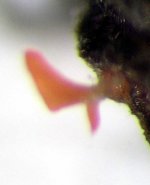milica said:
Hello my new friends. I am very happy to join in forum and I hope that you can help me.
I have problems about identification of small fungus (basidiocarp 1-2 mm) recorded on dead leave on Nepeta rtanjensis (Lamiaceae, endemic and threatened plant from Serbia).
The first impresion was that maybe member of fam Dacrymicetaceae or Typhulaceae (suggestion from my collegue from Mexico).
This identification is very important for my PhD.
Unfortunately I have not eny specimen. I have only photographs and one microscopic slide . Thank you very much in advance
p.s. Sorry for bed english
Hello milica. Welcome to the forum.
Naming your fungus is not going to be easy.
First, can I ask why you say it is a basidiomycete?
You have looked at a microscope slide and presumably you saw basidia, but how certain are you of this?
If you did see basidia, what features did they have - how many sterigmata, how long (relatively) were the sterigmata, were there any internal septa (transverse or longitudinal) in the basidia?
The basidia of the Dacrymycetales and Typhulales are very different (see diagrams in mycology textbooks) and you should have seen clues to eliminate one or other possibility.
Frankly, I don't think it belongs to either. There are some small members of the Dacrymycetales that could be that shape, but the consistency doesn't seem right and I would expect them on wood, not on leaves. I don't know of any member of the Typhulales that is at all like it. The Tremellales might be more promising, but again they are typically on wood (or on other fungi that are in the wood).
Unless you are really sure you saw basidia, I think you should be considering one of the small cup fungi (Ascomycota). I am assuming here that the fruit-body is basically a small, stalked cup, even though it is split (which is not important). At first glance this looks to me most like a species of
Hymenoscyphus - a large genus with many species on dead leaves. I could further
guess that it could be
Hymenoscyphus scutula (aggregate), simply on the basis that it is widespread and usually common in Europe, non host-specific, distinctly stalked, very variable in colour, often slightly tough in consistency (which means it has less transient fruitbodies that are more easily noticed and not confined to damp places) - and it can look like your photo! But that would be just a guess,
Hymenoscyphus species always need careful work.
If you did see definite basidia then I am wrong (and rather puzzled).
Incidentally, if you are thinking that this may be some special, host-specific fungus on your rare
Nepeta, this is unlikely. There are exceptions, but my experience with rare plants in Britain is that they tend not to be sources of equally rare fungi - being restricted to a rare host is not a great survival strategy for the fungus. So they tend to have generalists - such as
Hymenoscyphus scutula!
Alan




